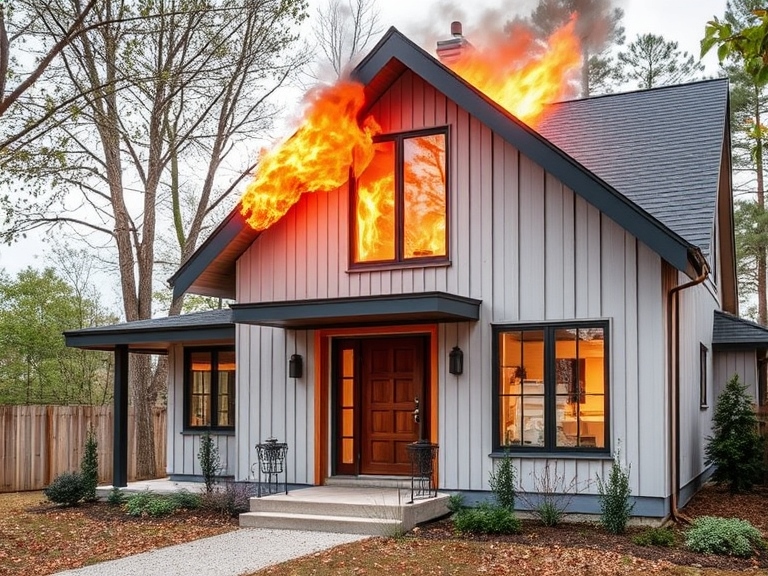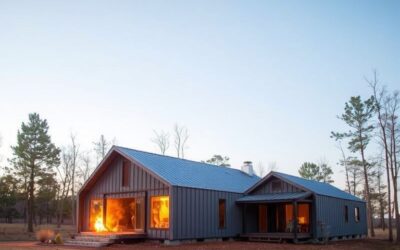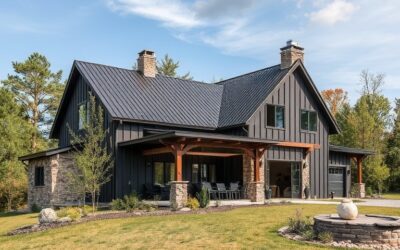Safety is key when building your home, and fire protection should be at the top of your list. Steel homes offer excellent fire safety features that set them apart from traditional homes. Understanding these features can help you make informed decisions for a safe living environment.
Steel homes are made entirely of fire-resistant materials, with 100% steel providing natural protection against fire. This brings peace of mind to homeowners, knowing their structure can withstand extreme conditions. And it’s not just the materials; modern technology has introduced advanced smoke and fire detection systems that add an additional layer of safety to steel homes.
Another important factor in fire safety is the electrical design and installation. Properly designed and installed electrical systems reduce the risk of electrical fires. Combined with best practices for fire safety, these features ensure a comprehensive approach to protecting your home and family.
Knowing the top fire safety features of steel homes can help you feel secure in your decision to invest in this type of construction. By choosing a steel home, you are taking an active step in creating a safer living space for you and your loved ones.
Fire-Resistant Materials: The Backbone of Steel Homes
One of the best perks of steel homes? Fire-resistant materials! Steel doesn’t catch fire, making it a top choice for fire protection. and its high melting point can withstand extreme temperatures, providing a strong defense against potential fire hazards. This makes steel an excellent choice for the main structure of your home.
In addition to the steel frame, other materials used in steel homes offer fire-resistant properties. For instance, steel panels for both the exterior and interior walls provide additional layers of protection. These panels do not burn and can prevent flames from spreading quickly. Plus, using non-combustible insulation materials, like the closed-cell spray foam we use, which is fire resistant, helps keep the inside of your home even safer.
Roofing in steel homes also plays a vital role in fire safety. Metal roofing materials are not only durable and long-lasting but also resistant to fire. Compared to traditional roofing materials, metal roofs are less likely to ignite from flying embers during a wildfire. By choosing fire-resistant materials, you significantly reduce the risk of fire damage to your home.
Advanced Smoke and Fire Detection Systems
But fire safety doesn’t stop with materials. Modern smoke and fire detection systems are a must-have for your steel home. Modern detection systems have come a long way, offering quicker response times and better accuracy. These systems can alert you to the presence of smoke or fire, giving you the crucial time needed to respond effectively.
There are various types of smoke detectors available. Ionization smoke detectors are good at detecting fast-burning fires, while photoelectric detectors are better for slow, smoldering fires. Many newer detection systems combine both types to offer comprehensive coverage. Installing these detectors in key areas such as kitchens, hallways, and bedrooms enhances your home’s safety.
Another key feature is interconnected smoke alarms. When one alarm detects smoke, all alarms in the house go off. This early warning system ensures everyone in the home is alerted promptly, even if the fire starts in a distant room. Smart smoke detectors can also send alerts to your phone, allowing you to take action even when you’re not at home.
By incorporating advanced smoke and fire detection systems, you add a crucial layer of protection to your steel home. These systems, combined with fire-resistant materials, offer a robust defense against fire hazards, ensuring a safer living environment for you and your family.
Safe Electrical Design and Installation
Electrical safety is key when it comes to preventing fires. A well-planned electrical system is essential for steel homes, reducing the risk of common fire hazards. Steel homes benefit from meticulous planning and execution of electrical systems to keep home fires at bay.
First, using the right materials for electrical wiring is essential. Insulated copper wiring is a good choice because of its conductivity and durability. All connections should be secure and protected to prevent sparks that could ignite a fire. Another important aspect is using circuit breakers and fuses that are correctly rated for your home’s electrical load. These devices are your first line of defense against electrical fires.
Additionally, proper placement of electrical outlets and switches can reduce fire risks. Outlets should not be overloaded, so it’s a good idea to have enough of them to accommodate all your appliances and devices. Installing ground fault circuit interrupters (GFCIs) in bathrooms, kitchens, and outdoor areas adds extra safety. GFCIs cut power when they detect electrical imbalances, reducing the risk of electric shocks and fires.
Regular inspections and maintenance of your electrical system are also key. This includes checking for frayed wires, loose connections, and other wear and tear. Addressing these issues early helps avoid dangerous situations later on. A safe electrical system forms a strong foundation for fire safety in your steel home.
Best Practices for Fire Safety in Steel Homes
Even with all the fire-resistant materials and advanced systems, following basic fire safety practices is still a must. These practices can make a big difference in how well you and your family are protected in case of a fire.
1. Create a Fire Escape Plan: Have a clear plan that everyone in the house knows. Practice it regularly, so everyone knows what to do and where to go if there’s a fire.
2. Keep Flammable Materials Away: Store flammable items like oils, paints, and cleaning supplies in safe areas away from heat sources. Ensure that these materials are kept in proper containers.
3. Install Fire Extinguishers: Have fire extinguishers readily accessible in key areas like the kitchen, garage, and near heating equipment. Make sure everyone knows how to use them.
4. Regularly Check Alarms: Test smoke and fire alarms every month and replace batteries at least once a year. Replace the entire unit every ten years or as recommended by the manufacturer.
5. Mind the Kitchen: Never leave cooking unattended. Keep flammable items like dish towels and paper towels away from the stove.
6. Proper Usage of Heaters: Make sure space heaters are at least three feet away from anything flammable. Turn them off when you leave the room or go to bed.
By following these best practices, you add another layer of safety to your steel home. Being proactive and prepared can save lives and property in the event of a fire.
Conclusion
Fire safety should be a top concern for every homeowner—and steel homes give you the protection you need. From fire-resistant materials that form the backbone of your home to advanced detection systems and well-planned electrical designs, steel homes are built to protect. Understanding and implementing these features helps ensure a safe environment for you and your family.
By choosing a steel home and following best practices for fire safety, you are making a wise investment in your future. Steel homes offer durability and peace of mind that other types of construction simply can’t match.
At Wink Panels LLC, we are committed to helping you create a home that is both beautiful and safe. Contact us today to learn more about our 100% steel constructed home solutions such as insulated steel panels and how we can help you achieve the highest levels of fire safety in your new home. Let’s build your safe haven together.




